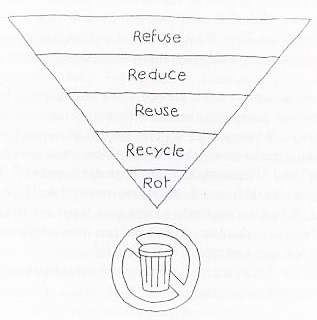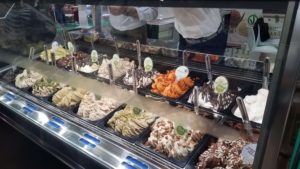- The Meaning of Critical Thinking: A Key Skill for Navigating Today’s Information Landscape - November 3, 2025
- Grandparents Can Develop Activist Grandchildren - September 29, 2025
- Top Six Reasons Credit Union Benefits Are a Smart Choice Over Banks - August 18, 2025
Last Updated on October 23, 2024
How to Use Your Stuff to Make the World a Better Place
Just north of me is the Museum of Appalachia, created by John Rice Irwin. As I browsed the recreation of a frontier village, I was struck by a quote from a frontier woman,
“Everything we had we made.”
To survive, she had to create everything from scratch. Fortunately, that is not true for us, but this woman’s quote is a reminder that we can try a different approach to our consumption, one that betters our lives and makes the world a better place.
Bea Johnson, the author of Zero Waste Home: The Ultimate Guide to Simplifying Your Life and Reducing Your Waste, summarizes her approach in this graphic:

Refuse: Say No to Giveaways
This interesting addition of ‘refuse’ to the traditional ‘reduce, reuse, recycle’ approach focuses on the stuff we accumulate for free. In my house, evidence of our inability to refuse includes hundreds of pens, some we never use because by the time it is their turn, the ink has dried up. And although I’ve done my best to stop junk mail, usually we don’t want more than half of our mailbox contents.
Just say no.
[Are you passionate about the environment? Learn more about environmental activism.]
Reduce: The Impact of Your Consumption
If you don’t have a way to manage your purchases, you end up with more than you need. It can sneak up on you. When you dig deep in your pantry, you find the seven bottles of ketchup you got on sale. All expired. Your linen closet filled with towels you never use.
My dresser drawers give me feedback. If they grow messy, I know I probably have items in the bottom that aren’t getting any use. When space is tight, I know I need to reconsider whether I’ve succumbed to buying too much or a reluctance to throw things away.
So, I organized my clothing using Marie Kondo’s technique from The Life-Changing Magic of Tidying Up. I love being able to see everything in my drawer rather than finding items I didn’t remember buried at the bottom. I also appreciated her technique of deciding whether an item sparks joy. My ‘good underwear’ is a form of joy, I think!
You can try not to buy things in the first place, or when you have to, be a savvy consumer. And when you purchase that product, you can take time to understand how companies create their goods and services. Your purchasing decisions can make the world a better place.
But what happens when you take your stuff home? You can make the world a better place in the ways you care for your material possessions. Once you bring an item into our home, you must find a place for it and maintain it. I don’t like that part of purchases. I don’t want to dust or find space in a cabinet or add batteries. So how can we change this? Through upkeep. Learn to use a needle and thread before you throw clothes away and buy more. Repair your appliances before sending them to the landfill.
“If we change our first response from ‘where can I get a new one?’ to ‘how can I fix this?’, we can start to change this consumer culture.” –Greenpeace
Reuse: Upcycling Can Make the World a Better Place
One of my favorite books is Amy Dacyczyn’s The Complete Tightwad Gazette: Promoting Thrift as a Viable Alternative Lifestyle. Some of her tips are genius. Others stretch the imagination. But she and her husband accomplished their financial goals – saving $50,000 (during the ’80s) on her husband’s Navy income, buying a home with acreage in Maine, and raising six children. And they were able to retire early.
Between Amy and my childhood love of Laura Ingalls Wilder’s Little House books, I’m inspired to try to get by with what we have. For example, I use plastic containers as tiny greenhouses and make rags from old towels.
My neighbor loved bluebirds, and when he died, I decided to honor him by continuing his practice of feeding birds. Unfortunately, this has spawned a war between the squirrels and me. I installed homemade squirrel baffles, made from upcycled materials. Squirrels are wily creatures, though, so sadly, I ended up buying a professional one for my main feeder. (Don’t worry about the squirrels – I rather enjoy their cheekiness and make sure they have corn cobs to snack on.)
Buy reusable over disposable items. Look for items that you can reuse; the little things can add up. For example, you can bring your silverware and cup to work, rather than using disposable items. Bea’s book inspired me to put together a basket for my car that includes napkins, utensils, and containers for leftovers.
Recycle: The Decision to Toss It
For many people, throwing something away is anxiety-provoking. However, evaluating how often you use it and how much maintenance you perform may help you decide to bless someone else with it.
“If there’s an emotional attachment (e.g. a gift from someone you care about) try to remember this: when it was presented as a gift, it already achieved its primary goal. Two or more years later, it’s just clothing taking up space. That doesn’t change the connection to the gift or the person who gifted it.” – Leon Ho
If you are lucky, you have access to curbside recycling. We are fortunate to have a recycling center in our city, but we have to haul our recyclables there. That’s okay; I’m still grateful for it.
There are also specialty recycling centers that take items like hazardous materials, cell phones, and plastic playsets. Go to the Earth911 website, put in your zip code, and see what you can recycle in your community. I tried a random item of ‘toothbrushes,’ and although there is no place locally, Earth911 provided several mail-in recycling options.
Rot: Build Your Soil
Rot is another addition to the traditional 3 R’s. Besides reducing what waste leaves my house, I’m motivated by the opportunity to make and add compost to my vegetable garden.
My composting includes a traditional container in my backyard, a bokashi bin in my garden shed, worms, leaf mold, and a brush pile.
-
- Backyard container – I layer yard materials, food waste, and shredded paper and let nature take its course.
- Bokashi bin – Bokashi is a Japanese style of composting that is more like pickling. The bokashi organisms break down the food material in two weeks. Then you can add the compost directly to your garden. Although I don’t eat meat or animal products, apparently, bokashi can be used on them, too.
- Worms – I love my worms. Put food waste in and get fantastic compost out.
- Leaf mold – We have many large trees, so my husband rakes up the leaves and mulches them with the lawnmower. I add the resulting leaf mold to my garden beds.
- Brush pile – I created a brush pile mainly to provide an environment for wild critters in my yard. But it is also a method of composting. The logs and large sticks take years to break down, but the resulting compost is spectacular.
The Five Rs Make the World a Better Place
Are we near being a zero-waste home? No, but I see progress. Zero Waste Home inspired me to set up containers in our bathrooms to capture recyclables and compostables we had not been collecting. And I decided to take my own advice and search for stores with bulk food options. The only co-op in my area is about 30 miles away, but I joined yesterday and with planning, I think I can reduce those Amazon packages that appear on my doorstep.
READ NEXT
Ideas on How to Reduce and Reuse
How to Make Your Garden Healthy Using the Easiest Eco-Friendly Way to Compost
Worms in Your House? How To Embrace Vermicomposting and Receive Glorious Fertilizer in Return
Learn more about Getting Started in Activism.
- Focus your passion and find the cause closest to your heart among the myriad of causes.
- Match your skills with the type of activism work that best suits you.
- Find an activism opportunity that works for your life.
- Determine if your social justice work truly makes an impact.
- Stay motivated in your activism for the long term.




Pingback: #SeniSal Roundup: Jan 27-31 ~ Esme Salon
Pingback: Eye-Opening Ways Nature’s Sounds, Smells, and Sights Can Heal You
Pingback: Eye-Opening Ways Nature’s Sounds, Smells, and Sights Can Heal You – Vegan Blount County
Pingback: How To Get Started in Vegan Permaculture – Vegan Blount County
Pingback: How To Make a Harvest Bag
Pingback: We Love This Deliciously Healthy Vegetarian Food Truck
Pingback: How to Perform Lawn Care that Supports Wildlife
Pingback: How To Increase Vegan Options in Your Hometown
Pingback: Support the Environment: Landscape Ideas to Delight You and Wildlife
Pingback: How to Perform Lawn Care That Improves the Environment
Pingback: Hillary Rettig Shows Us How To Create a Vegan-Friendly Community